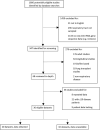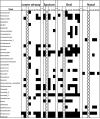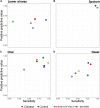Bacterial Signatures of Paediatric Respiratory Disease: An Individual Participant Data Meta-Analysis
- PMID: 35002989
- PMCID: PMC8733647
- DOI: 10.3389/fmicb.2021.711134
Bacterial Signatures of Paediatric Respiratory Disease: An Individual Participant Data Meta-Analysis
Abstract
Introduction: The airway microbiota has been linked to specific paediatric respiratory diseases, but studies are often small. It remains unclear whether particular bacteria are associated with a given disease, or if a more general, non-specific microbiota association with disease exists, as suggested for the gut. We investigated overarching patterns of bacterial association with acute and chronic paediatric respiratory disease in an individual participant data (IPD) meta-analysis of 16S rRNA gene sequences from published respiratory microbiota studies. Methods: We obtained raw microbiota data from public repositories or via communication with corresponding authors. Cross-sectional analyses of the paediatric (<18 years) microbiota in acute and chronic respiratory conditions, with >10 case subjects were included. Sequence data were processed using a uniform bioinformatics pipeline, removing a potentially substantial source of variation. Microbiota differences across diagnoses were assessed using alpha- and beta-diversity approaches, machine learning, and biomarker analyses. Results: We ultimately included 20 studies containing individual data from 2624 children. Disease was associated with lower bacterial diversity in nasal and lower airway samples and higher relative abundances of specific nasal taxa including Streptococcus and Haemophilus. Machine learning success in assigning samples to diagnostic groupings varied with anatomical site, with positive predictive value and sensitivity ranging from 43 to 100 and 8 to 99%, respectively. Conclusion: IPD meta-analysis of the respiratory microbiota across multiple diseases allowed identification of a non-specific disease association which cannot be recognised by studying a single disease. Whilst imperfect, machine learning offers promise as a potential additional tool to aid clinical diagnosis.
Keywords: individual participant data (IPD) meta-analysis; meta-analysis; microbiota (16S); paediatrics; respiratory infection; respiratory tract.
Copyright © 2021 Broderick, Waite, Marsh, Camargo, Cardenas, Chang, Cookson, Cuthbertson, Dai, Everard, Gervaix, Harris, Hasegawa, Hoffman, Hong, Josset, Kelly, Kim, Kong, Li, Mansbach, Mejias, O’Toole, Paalanen, Pérez-Losada, Pettigrew, Pichon, Ramilo, Ruokolainen, Sakwinska, Seed, van der Gast, Wagner, Yi, Zemanick, Zheng, Pillarisetti and Taylor.
Conflict of interest statement
MPi reports personal fees from Mérieux Université, grants from Abacus Diagnostica, outside the submitted work. AM reports grants and personal fees from Janssen, personal fees from Merck, personal fees from Sanofi-Pasteur, personal fees from Roche, outside the submitted work. EZ reports grants and personal fees from Cystic Fibrosis Foundation, outside the submitted work. OS is an employee of Nestlé Research – Societé des Produits Nestlé S.A. The remaining authors declare that the research was conducted in the absence of any commercial or financial relationships that could be construed as a potential conflict of interest.
Figures





Similar articles
-
Human microbiota dysbiosis after SARS-CoV-2 infection have the potential to predict disease prognosis.BMC Infect Dis. 2023 Nov 29;23(1):841. doi: 10.1186/s12879-023-08784-x. BMC Infect Dis. 2023. PMID: 38031010 Free PMC article. Review.
-
A Machine Learning Approach Reveals a Microbiota Signature for Infection with Mycobacterium avium subsp. paratuberculosis in Cattle.Microbiol Spectr. 2023 Feb 14;11(1):e0313422. doi: 10.1128/spectrum.03134-22. Epub 2023 Jan 19. Microbiol Spectr. 2023. PMID: 36656029 Free PMC article.
-
Nasopharyngeal Microbiota in Children With Invasive Pneumococcal Disease: Identification of Bacteria With Potential Disease-Promoting and Protective Effects.Front Microbiol. 2019 Jan 28;10:11. doi: 10.3389/fmicb.2019.00011. eCollection 2019. Front Microbiol. 2019. PMID: 30745895 Free PMC article.
-
Infant respiratory syncytial virus prophylaxis and nasopharyngeal microbiota until 6 years of life: a subanalysis of the MAKI randomised controlled trial.Lancet Respir Med. 2020 Oct;8(10):1022-1031. doi: 10.1016/S2213-2600(19)30470-9. Epub 2020 Mar 20. Lancet Respir Med. 2020. PMID: 32203712 Clinical Trial.
-
Association of upper airway bacterial microbiota and asthma: systematic review.Asia Pac Allergy. 2022 Jul 29;12(3):e32. doi: 10.5415/apallergy.2022.12.e32. eCollection 2022 Jul. Asia Pac Allergy. 2022. PMID: 35966153 Free PMC article. Review.
Cited by
-
Realising respiratory microbiomic meta-analyses: time for a standardised framework.Microbiome. 2023 Mar 22;11(1):57. doi: 10.1186/s40168-023-01499-w. Microbiome. 2023. PMID: 36945040 Free PMC article.
-
Time to re-set our thinking about airways disease: lessons from history, the resurgence of chronic bronchitis / PBB and modern concepts in microbiology.Front Pediatr. 2024 Jun 7;12:1391290. doi: 10.3389/fped.2024.1391290. eCollection 2024. Front Pediatr. 2024. PMID: 38910961 Free PMC article. Review.
-
Benchmarking 16S rRNA Gene-Based Approaches to Bacterial Taxonomy Assignment Based on Amplicon Sequencing With Illumina and Oxford Nanopore.Int J Microbiol. 2025 Aug 13;2025:7563096. doi: 10.1155/ijm/7563096. eCollection 2025. Int J Microbiol. 2025. PMID: 40843178 Free PMC article.
-
Dpr-mediated H2O2 resistance contributes to streptococcus survival in a cystic fibrosis airway model system.J Bacteriol. 2024 Jul 25;206(7):e0017624. doi: 10.1128/jb.00176-24. Epub 2024 Jun 28. J Bacteriol. 2024. PMID: 38940597 Free PMC article.
-
The Respiratory Microbiome in Paediatric Chronic Wet Cough: What Is Known and Future Directions.J Clin Med. 2023 Dec 28;13(1):171. doi: 10.3390/jcm13010171. J Clin Med. 2023. PMID: 38202177 Free PMC article. Review.
References
-
- Biesbroek G., Tsivtsivadze E., Sanders E. A., Montijn R., Veenhoven R. H., Keijser B. J., et al. (2014). Early respiratory microbiota composition determines bacterial succession patterns and respiratory health in children. Am. J. Respir. Crit. Care Med. 190 1283–1292. 10.1164/rccm.201407-1240oc - DOI - PubMed
-
- Bui D. S., Lodge C. J., Burgess J. A., Lowe A. J., Perret J., Bui M. Q., et al. (2018). Childhood predictors of lung function trajectories and future COPD risk: a prospective cohort study from the first to the sixth decade of life. Lancet Respir. Med. 6 535–544. 10.1016/S2213-2600(18)30100-0 - DOI - PubMed
Grants and funding
LinkOut - more resources
Full Text Sources

